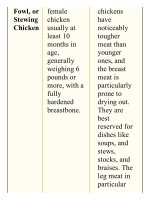The food lab better home cooking through science ( PDFDrive ) 700
Bạn đang xem bản rút gọn của tài liệu. Xem và tải ngay bản đầy đủ của tài liệu tại đây (177.63 KB, 2 trang )
kebabs and stir-fries, pretty much any recipe that calls for
boneless,skinlesschickenbreastswillworkjustaswelland
taste far better if you start with bone-in, skin-on chicken.
Boththeribcageandtheskinactasinsulators,allowingthe
meattocookmoregentlyandevenly,aswellaspreventing
it from losing too much moisture by keeping the surface
covered. If you really don’t want the skin, pull it off and
throw it outafter cooking. But save those rib cages for
stock! I keep extra chicken parts in a gallon-sized zipperlockbaginthefreezer,thenpullitoutwhenit’sfulltomake
a big batch of stock (seehere); even cooked rib cages will
addflavortothestock.
Legs are a slightly different story. I usually buy bone-in,
skin-on legs because I just can’t get enough of chicken
skins, but if a recipe specifically calls for boneless thighs,
I’ll buy them boned. Boning thighs is not a fun task, no
matterwhatanyonetellsyou.
SAFETYANDSTORAGE
Q:Ishandlingrawchickenandturkeyreallyas
dangerousaspeoplesayitis?
Not nearly. There have been more reported cases of
salmonella poisoning in the last decade from cantaloupe
than from chicken. That said, it’s always better to be safe
thansorry.Afterworkingwithrawpoultry, alwayscarefully
scrub your cutting board, knife, hands, and any other
surfaces the poultry may have come in contact with using
warm soapy water, and dry them well. To avoid crosscontamination,neverusetheboardorknifeforotherfoods
untilafterthey’vebeencleaned.
Q:Whatisthebestwaytostorepoultryinthefridge?
Poultryandotherrawmeatsshouldalwaysbestoredonthe
bottomshelfofthefridge,towardtheback.Thisisasafety
measure intended to prevent any raw juices from dripping
onto foods below the meat. Fresh poultry in a Cryovac
package should remain fresh for a very long time—with
turkey, as long as a couple of weeks. Once opened,
however,it’sbesttousepoultryassoonaspossible.Itryto
useminewithin2daysofpurchase.
Q:Isitagoodideatofreezepoultry?
Freezingpoultryisperfectlyfine,thoughyoushouldexpect
ittolosesomemoistureandbecometougherintheprocess
—freezingcauseslargeicecrystalstoformwithinthemeat
that can pierce cells and cause fluid loss. If the meat isn’t
properly wrapped, you can also expect to see freezer burn
over time—the sublimation of ice into water vapor that
leavesthesurfaceofthemeatdryandstringy.
Togetthebestresultswhenfreezingpoultry,youshould
first break down whole birds. Smaller parts freeze faster,
minimizing ice-crystal formation.Airtight packaging is the
only way to prevent freezer burn, and though it may not
seem like it, plastic wrap is actually “breathable” (not that
you should try breathing through it!), allowing air to pass
through it at a very slow rate—that’s why that onion you
wrappedinplasticwrapstillmanagestostinkupthewhole
fridge.You’remuchbetteroffusingheavy-dutyplasticbags
specifically designed for the freezer or, better yet, a









